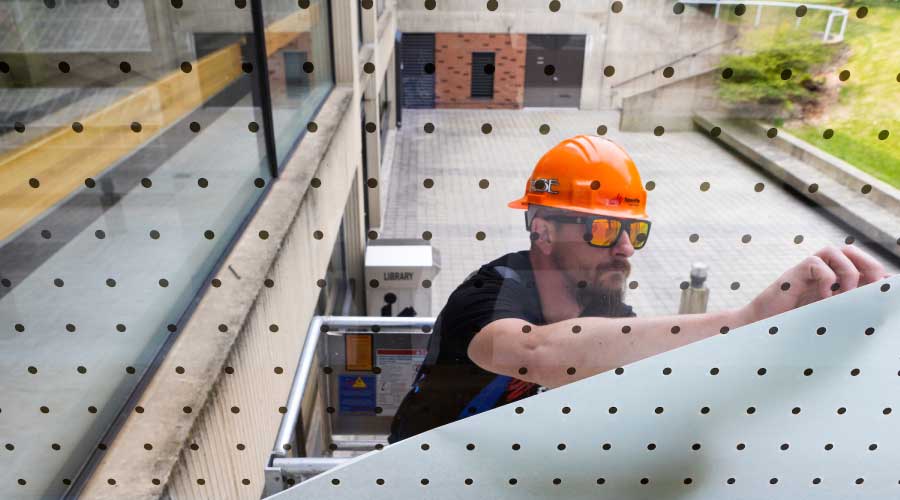 The CenturyLink Technology Center of Excellence incorporates 37,000 square feet of electrochromic glass. The use of smart glass allowed the HVAC system to be downsized by 11 percent, according to View, Inc., the manufacturer of the glass.View, Inc.
The CenturyLink Technology Center of Excellence incorporates 37,000 square feet of electrochromic glass. The use of smart glass allowed the HVAC system to be downsized by 11 percent, according to View, Inc., the manufacturer of the glass.View, Inc.Smart Windows Offer Flexibility, Occupant Comfort
Whether based on sunlight or electricity and controls, smart glass shifts between clear and tinted states, offering many benefits, including energy efficiency.
At a time when everything seems to be a “smart” technology, windows are no different. Smart windows are based on dynamic technologies that can alter the tint of the window, in response to the outside weather or the need for privacy indoors.
While these types of glass can be used in a variety of settings, there are four in use within commercial facilities: thermochromic, electrochromic, polymer dispersed liquid crystal, and suspended particle device. Each offers different benefits, so facility managers considering these products have many factors to consider.
While all smart glass technologies aim for basically the same goal — enabling glass to shift between clear and tinted states — the way they function is very different. Smart windows can be grouped into two general categories: passive glass technology that darkens automatically in response to heat or light, and active glass products that tint or lighten in response to electricity.
Thermochromic glass falls into the first category. It darkens as heat from direct sunlight warms the glass. This product needs no external power to work. “ Just the like the hood of the car exposed to sunlight, glass in the window frame reaches high temperatures when the sun shines on it, even in cool winter temperatures,” says Patrick Lentz, director of marketing, Pleotint. “ This heat changes the configuration of thermochromic elements (metal ions), embedded in a PVB interlayer, which causes them to darken in color. The technology of thermochromic dynamic glass is self-contained, and it starts working as soon as it’s exposed to direct sunlight.” Pleotint makes the only thermochromic glass product on the market, Lentz says, and the company has completed about 350 building installations worldwide.
Photochromic glass is also activated by light. This is what’s seen in transition eyewear, says Erich Klawuhn, vice president of product management at View, Inc., but as of now, “there are no technologies available for buildings.”
Electrochromic technology taking hold
Most of the smart windows focus now is on glass that functions through some kind of electrical charge. Indeed, in a report released in May, analyst firm IDTechEx Ltd. maintains that “electrically active see-through glass is an idea whose time has come.”
Another research firm echoed that conclusion. In an October 2016 blog, n-tech Research, said it “is seeing a maturing of the smart windows sector with electrochromic (EC) windows beginning to take a dominant role in smart windows for buildings.”
More recently, in an April report, n-tech estimated that electrochromic materials will make up 65 percent of a projected $1.1 billion in revenue from smart windows materials by 2022. That number includes a variety of applications, including building construction, automobiles, public transportation, and aerospace uses.
Electrochromism was discovered more than 50 years ago, Klawuhn explains. An electrochromic object can “ change its optical properties in the presence of an ion injected into that material” when an electric voltage is applied, Klawuhn says.
“ Applying a low voltage of electricity darkens the coating as lithium ions and electrons transfer from one electrochromic layer to another electrochromic layer,” says Ryan Park, global head of marketing and product management at SageGlass. “ Reversing the voltage polarity causes the ions and electrons to return to their original layer, causing the glass to return to its clear state.”
SageGlass was the first company to enter this market, launching its product in 2003 and completing 700 projects to date. About four years ago, View, Inc., launched its electrochromic product and now has finished more than 300 installations. And then late last year, Kinestral Technologies launched its product, completing one installation since then.
Because electrochromic glass is “voltage-activated, you can have fairly sophisticated algorithms” controlling the tinting, Klawuhn says. View uses astronomical and solar tracking data in its algorithm to calculate the best settings based on where a facility is located, what direction it’s facing, and where the sun’s glare is originating. Sensors on a facility roof can detect whether there are clouds in the sky, and the system, which is connected to the Internet, can access application programming interfaces for weather in the same way as a smartphone to gather additional data.
According to Henricksen, Kinestral’s glass technology, known as Halio, “ starts tinting within 15 to 20 seconds and achieves its darkest tint in less than three minutes.” Its clear state is “indistinguishable from conventional glass,” and its tinted state is “neutral gray hues.” The tinting speed and color allow this glass to be used for walls and partitions within facilities. Finally, he says, its tint is more even, and users can stop the tinting process whenever they would like.
Electrochromic glass isn’t the only technology to use electricity to change the tint of a window. In lesser use among buildings are polymer dispersed liquid crystal and suspended particle devices. Like electrochromic glass, these electrically active glass technologies come in insulated glass units with wiring, notes Lentz.
Polymer dispersed liquid crystal glass “ uses electricity to change the orientation of suspended liquid crystals, which either scatter light or let light pass through, depending on the voltage,” says Craig Henricksen, vice president of marketing for Kinestral. This product “ switches nearly instantaneously and provides privacy. The downside to this technology is that not only is the clear state actually hazy but it also requires high voltage to stay ‘clear.’ Otherwise, it will turn opaque.” This kind of glass “ is typically used for interior applications” in which “ occupants want the flexibility of changing open areas to more private areas,” such as in offices and medical facilities, says Lentz.
Suspended particle device glass works in a way comparable to polymer dispersed liquid crystal “ in that in its static state, scattered particles block light, and when an electric charge is applied, the particles align to allow light through and appear transparent,” Henricksen explains. This technology “ can tint smaller windows quickly, and glass can be ordered in many different shapes,” says Lentz. “ The user can activate the glass and, in this way, eliminate glare.” It is “ mostly used for smaller exterior surface areas,” and besides facilities, the product is used in the roof glass of cars and windows in airplanes.
The April n-tech report predicts that suspended particle device products will see revenues of about $280 million by 2022, largely driven by automotive use.
Related Topics:












